Located in the northeast corner of Beijing, the Yonghe Lama Temple, also known as Yonghe Gong (雍和宫), has a rich history dating back to the Qing Dynasty. In 1694, during the 33rd year of Emperor Kangxi’s reign, the palace was constructed and given to his fourth son, Yinzhen, who later became Emperor Yongzheng. In 1725, the residence was transformed into an imperial palace and named Yonghe Gong. Following Emperor Yongzheng’s death in 1735, his coffin was temporarily placed here, leading to the main halls’ green glazed tiles being replaced with yellow ones, a color reserved for royalty.
Yonghe Gong holds significant historical importance as both Emperor Yongzheng and his son, Emperor Qianlong, were born here. This connection to two emperors bestowed the temple with the designation “Dragon Spirit’s Abode,” a term indicating imperial favor. Consequently, the buildings feature yellow tiles and red walls, mirroring the grandeur of the Forbidden City. In 1744, during the ninth year of Emperor Qianlong’s reign, Yonghe Gong was converted into a Lama temple. The temple was managed by high-ranking officials appointed by the emperor, making it the central hub for managing Tibetan Buddhist affairs across China during the latter part of the Qing Dynasty.
Yonghe Lama Temple is renowned as the highest-ranking Buddhist temple of its time in China. The complex comprises three exquisite archways and five grand halls. From the intricately designed East and West Archways to the ancient East and West Shunshan Buildings, the temple spans an area of 66,400 square meters and contains over a thousand rooms. The architecture of Yonghe Gong is a stunning example of traditional Chinese design, featuring flying eaves and bracket sets that showcase the artistic and cultural achievements of the Qing Dynasty.
Today, Yonghe Lama Temple stands as a vital center for Tibetan Buddhism and a significant cultural heritage site, attracting countless visitors who come to admire its historical, religious, and architectural splendor.
Table of Contents
- Basic Information
- Location and Transportation
- Highlights of Yonghe Lama Temple
- Map and Recommended Routes
- Vlog about Yonghe Lama Temple
- Important Tips for Offering Incense
- Popular Restaurants near Lama Temple
- Useful Tips Summarized from Reviews
- Attractions near Yonghe Temple
- Explore Beijing Like A Local
Basic Information
| Website | http://www.yonghegong.cn/ |
| Estimated Length of Tour | 1 – 3 hours |
| Ticket Price | Adult: 25 RMB Adolescents between 6 and 18 years old: 12 RMB Seniors over 60 years old: 12 RMB Children under 6 years old or below 1.2 meters: Free |
| Opening Hours | 9.00 – 17.00; Last admission: 16.30 (1st April – 31st October) 9.00 – 16.30; Last admission: 16.00 (1st November – 31st March the next year) |
| Telephone Number | 0086-010-84191906 0086-010-84191907 0086-010-84191908 |
Location and Transportation
Yonghe Lama Temple is located at No.12 Yonghegong Street, in the Dongcheng district of Beijing, China. It is situated in the northeast part of the city, near the Second Ring Road, making it easily accessible by public transportation.
Bus: Take bus 13, 84, 116, or 117, get off at Yonghe Lama Temple (雍和宫), and walk about 50 meters to the south to reach the entrance.
Subway: Take subway line 5, get off at Yonghe Lama Temple, exit from Exit F, and you will be standing at the entrance to the Lama Temple.
Self-drive: There is no parking lot near Yonghegong, so we do not recommend you drive yourself there.
Highlights of Yonghe Lama Temple
Yonghe Gate
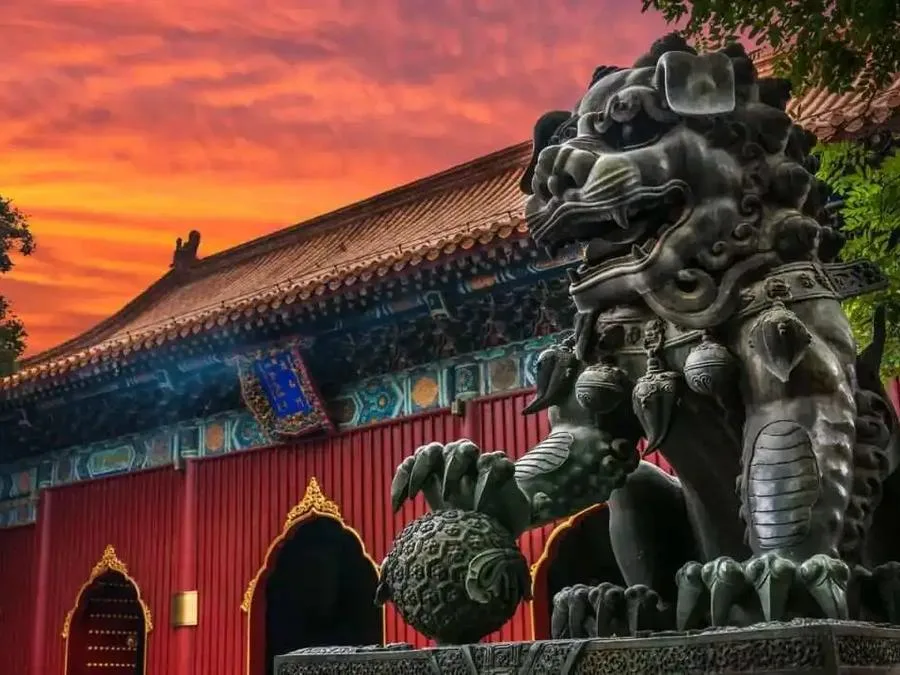
Between two pavilions stands the Yonghe Gate, adorned with a large plaque bearing Emperor Qianlong’s hand-written inscription “雍和门.” Equivalent to the mountain gate and the Hall of Heavenly Kings in Han Chinese Buddhism, this entrance is guarded by lifelike bronze lions. Inside the hall, at the center of the golden throne, sits a smiling Maitreya Buddha statue, bare-chested and jovial. Flanking the main hall on both sides are vividly colored clay statues of the Four Heavenly Kings, standing opposite each other. With their feet trampling demons, these kings symbolize their duty to subdue evil and protect the world. Behind the Maitreya statue is the protector deity Wei Tuo, depicted standing on floating clouds adorned in armor and helmet.
Main Hall of Yonghe Temple

Exiting through Yonghe Gate, visitors encounter a series of features in the courtyard, including bronze cauldrons, imperial steles, a bronze Mount Sumeru, prayer flags, and the main hall of Yonghe Temple. Originally known as the Hall of Silver Peace, the main hall served as an audience hall for Prince Yong to receive officials before being converted into a Lama temple. It now serves as the equivalent of the Mahavira Hall in typical Buddhist temples. Inside, facing north, are three nearly two-meter-tall bronze statues representing the Three Buddhas of the Three Ages. These statues depict Shakyamuni Buddha in the center, Medicine Buddha to the left representing the Eastern world, and Amitabha Buddha to the right representing the Western world. This arrangement symbolizes the omnipresence of Buddhas across space, hence referred to as the “horizontal Three Buddhas.” Additionally, in the northeast corner of the main hall stands a bronze statue of Guanyin, while in the northwest corner stands a bronze statue of Maitreya. Adorning the throne platforms in front of the mountain walls are eighteen Arhats. Flanking the courtyard in front of the main hall are the “Four Learning Halls.”
Yongyou Hall

Located immediately after the Main Hall, the Yongyou Hall features a single-eaved gable and hip roof with a “five-visible, ten-hidden” architectural style. Despite appearing as five separate rooms from the outside, it is actually two sets of five rooms combined into one. During the prince’s residence, the Yongyou Hall served as both his study and bedroom. Later, it was repurposed as an ancestral hall for the Qing emperors. “Yongyou” means eternal blessing for the departed spirits of the emperors. At the center of the lotus throne inside the hall, there are three 2.35-meter-tall Buddha statues crafted from sandalwood. The central figure represents Amitabha Buddha, while to the left stands Bhaisajyaguru, and to the right is Simhanada. Exiting the Yongyou Hall leads to the Wheel Hall, flanked by the Panchen Lama Tower and the Ordination Platform Tower on both sides. The plan of the Wheel Hall resembles a cross, with five skylights and five golden copper pagodas, reflecting traditional Tibetan architectural forms.
Wheel Hall

The Wheel Hall is a harmonious blend of Han and Tibetan cultures. At the center of the hall, atop a massive lotus platform, sits a 6.1-meter-tall copper statue of Tsongkhapa, the founder of the Gelug school of Tibetan Buddhism, with a gentle smile on his face. This statue, sculpted in 1924, took two years to complete and cost 200,000 silver dollars. Behind the Tsongkhapa statue is the renowned Five Hundred Arhats Mountain, considered one of the three masterpieces of woodcarving in Yonghe Lama Temple. Measuring nearly 5 meters in height, 3.5 meters in length, and 30 centimeters in thickness, this masterpiece is intricately carved from rosewood. In front of the Five Hundred Arhats Mountain, there is a basin made of golden-thread nanmu wood, known as the “Three Washbasins.” Legend has it that Emperor Qianlong bathed in this basin three days after his birth.
The Tower of Ten Thousand Blessings

Exiting the Wheel Hall, visitors are greeted by the Tower of Ten Thousand Blessings, soaring 25 meters high with triple-tiered eaves. Flanking it are the Yǒngkāng Pavilion and Yánsuí Pavilion, connected by flying corridors, reminiscent of celestial palace towers, showcasing architectural styles from the Liao and Jin dynasties. Within the Tower of Ten Thousand Blessings stands the majestic statue of Maitreya Buddha, towering 18 meters high with 8 meters buried underground. This Buddha, with a width of 8 meters, is a masterpiece carved from a precious single piece of sandalwood, donated by the Seventh Dalai Lama as a tribute. Legend has it that Emperor Qianlong allocated over 80,000 taels of silver for the carving of this Buddha. This statue is also one of the three masterpieces of woodcarving in Yonghe Lama Temple. Another masterpiece, the Golden-threaded Nanmu Buddha Niche, is located in the east annex of the Tower of Ten Thousand Blessings, known for its intricate carving depicting 99 cloud dragons, each vividly lifelike.
The Bronze Mount Sumeru
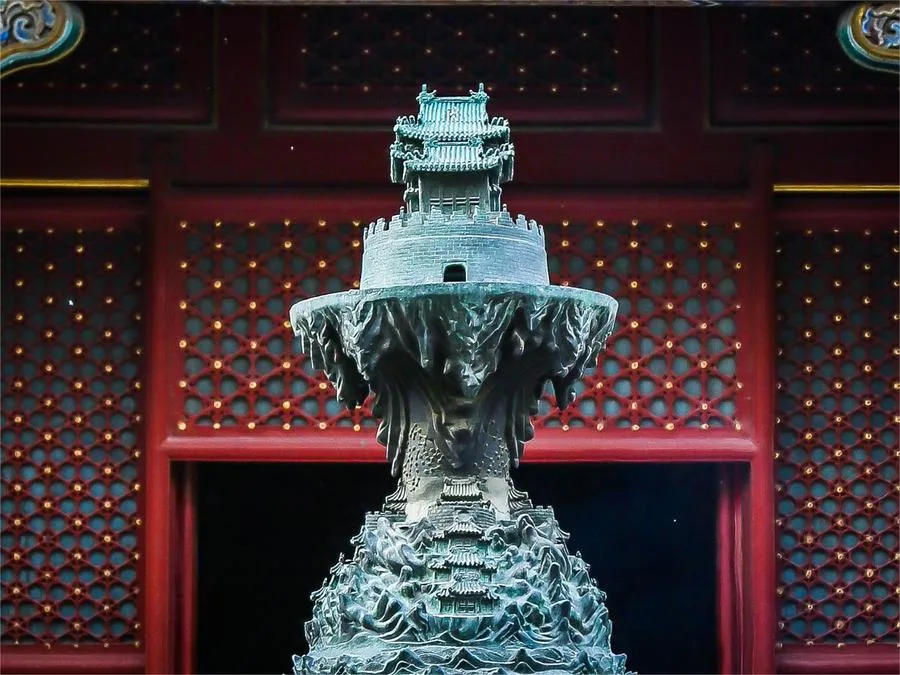
In the courtyard before the main hall of Yonghe Lama Temple, atop an oval-shaped marble base, sits a bronze “Mount Sumeru” standing at an impressive 1.5 meters tall. “Sumeru” is transliterated from Sanskrit and means “excellent and high.” It is a legendary mountain in ancient Indian mythology, believed to be the center of the world. At the summit of Mount Sumeru is “Indra’s Heaven,” beneath which lies a celestial chart depicting constellations arranged according to ancient astronomical observations. It is said that the distribution and markings of these constellations generally correspond to the research findings of modern astronomy. In Buddhism, Mount Sumeru is the tallest mountain in the world, and the realm of Indra’s Heaven at its peak is considered the highest realm, akin to paradise. Because Mount Sumeru is regarded as the “center of the world,” Buddha Shakyamuni often preached and taught here. Many statues of Buddhas in temples and grottoes are seated on “Sumeru thrones,” symbolizing this central significance.
The Wheel of Reincarnation
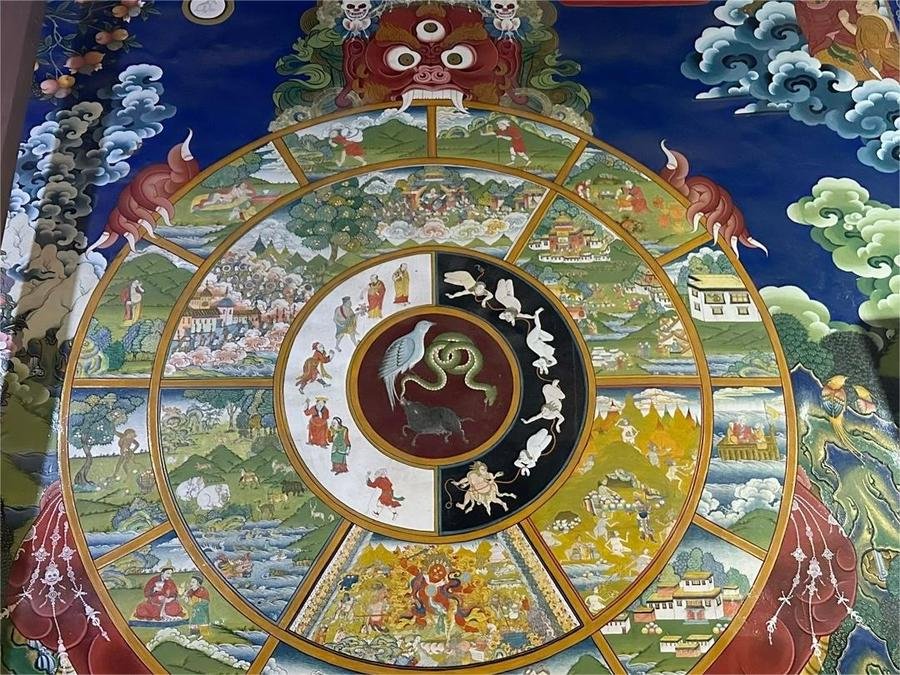
In the east wing of the Tower of Ten Thousand Blessings at Yonghe Lama Temple is the Hall of Illumination, originally a place for Emperor Qianlong’s mother to worship Buddha. Inside, there are two paintings displayed: one depicting the Buddha and the other the “Wheel of Reincarnation.” Buddhism advocates for the equality of all sentient beings, believing that beings are caught in an endless cycle of reincarnation, with equal opportunities in each lifetime. After death, there are six possible “destinations” in the next life: gods, humans, asuras, animals, hungry ghosts, or hell beings. The “Wheel of Reincarnation” depicts a monstrous creature with long claws and three eyes, resembling a black bear, sitting on the ground, holding a large wheel-shaped circle. Various characters and scenes depicting evil deeds such as burning, killing, adultery, deceit, robbery, theft, gluttony, drinking, prostitution, and gambling are painted around the circle. Several streams of air divide the circle into six realms. The first realm shows a magnificent celestial palace surrounded by colorful clouds, representing the “realm of the gods.” The second realm depicts ordinary society with common people, known as the “realm of humans.” The third realm is characterized by chaos and disasters, including wars, floods, fires, and droughts, known as the “realm of asuras.” The fourth realm portrays tortured ghosts, thin and skeletal, undergoing punishment, known as the “realm of hungry ghosts.” The fifth realm shows various animals, including pigs, dogs, cattle, horses, fish, insects, and other creatures, known as the “realm of animals.” The sixth realm depicts hellish landscapes with mountains of knives, icy valleys, and seas of fire, where ghosts suffer torment, known as the “realm of hell.” This painting vividly warns people to refrain from evil deeds and to practice virtuous acts in order to achieve the goal of urging people to do good and avoid evil.
Map and Recommended Routes
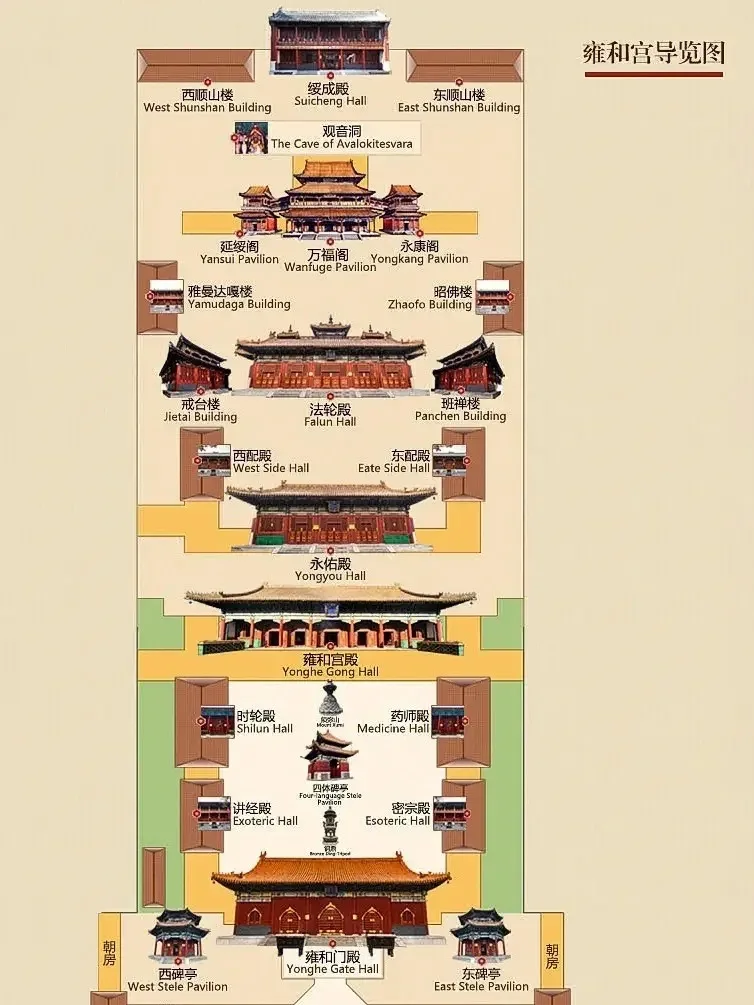
| Route | Function |
|---|---|
| Shulin Avenue | N/A |
| Incense Offering Station | Get incense for worship |
| Zhaotai Gate Side Entrance | Enter the temple |
| Yonghe Gate Hall (雍和门殿) | Happiness and Smooth Success |
| Jiangjing Hall (讲经殿) | Peace and Safety |
| Yonghe Palace (雍和宫殿) | Wealth and Prosperity |
| Faluon Hall (法轮殿) | Career Success |
| Shilun Hall (时轮殿) | Transformation and Disaster Relief |
| Yongyou Hall (永佑殿) | Exorcism and Disaster Relief |
| West Side Hall (西配殿) | Academic Success |
| Wanfu Pavilion (万福阁) | Front: Good Fortune and Safety |
| Back: Marriage and Childbirth | |
| Suicheng Hall (绥成殿) | Good Luck and Fulfillment |
| East Side Hall (东配殿) | Wealth and Prosperity |
| Yaochi Hall (药师殿) | Health and Healing |
| Mizong Hall (密宗殿) | Peace and Security |
| Exit | Leave through the side door |
Vlog about Yonghe Lama Temple
Important Tips for Offering Incense
Do Not Walk Through the Center Door: When entering, avoid stepping directly on the threshold. Step over it carefully and enter with your left foot. When leaving, step out with your right foot.
Incense Holding: After receiving the incense, hold it with your left hand and support the base with your right hand.
Lighting the Incense: If the incense has already been lit, do not blow on the flame to extinguish it. Instead, gently fan it with your hand. It is traditional to use three sticks of incense, and they should be held at a height above your head.
Kneeling and Praying: Kneel on the cushion with both knees and join your hands in a prayer position, with palms facing up and thumbs pointing towards the center. Lift your hands above your head and then bring them down to your mouth as you make your wish. Next, bring your hands down to chest level, open your palms upwards, and bow your head in reverence. Ensure that your head touches the mat or the floor during the bowing. After the prayer, place the incense sticks in the incense burner.
No Incense Burning Inside: Do not light incense or take photos inside the main halls of the temple. However, it is permissible to take photos of the exterior buildings.
Wish-Making Guidelines: Make no more than three wishes. Making more than three wishes is considered greedy.
Return to Fulfill Your Wish: If your wish is granted, remember to come back within a year to show your gratitude.
Appropriate Attire: Wear modest clothing. Avoid wearing hats and sunglasses inside the main halls of the temple.
Popular Restaurants near Lama Temple
| Restaurant | Average Price | Specialties | Highlights |
|---|---|---|---|
| Yonghe Fried Chicken and Shaobing (雍和炸鸡烧饼) | ¥5 per item | Fried Chicken Legs, Shaobing | Crispy, juicy chicken legs at an affordable price; great value for money. |
| Wu Yutai Tea House (吴裕泰茶庄) | ¥20-¥50 | Flower Tea Ice Cream | Exquisite flower tea-flavored ice cream, refreshing and popular treat. |
| Milk Convenience (牛奶便利) | ¥10-¥20 | Yogurt Curd | Authentic yogurt curd, creamy and tangy, a traditional Beijing snack. |
| Pang Mei Noodle House (胖妹面庄) | ¥50-¥80 | Pea Noodles, Spicy Dumplings | Authentic Chongqing-style noodles and dumplings, rich and flavorful. |
| Liu A Mei Chicken Hot Pot (刘阿妹鸡煲.小火锅) | ¥80-¥120 | Chicken Hot Pot, Flavorful Broth | Tender chicken and rich broth; a must-try for hot pot lovers. |
| Cha Bing Zhai (茶饼斋) | ¥30-¥50 | Black Sesame Pastries, Taro Pastries, Red Tea Cheesecake | High-quality pastries with rich flavors; great for dessert lovers. |
| Peng Ji Iron Pot Intestines (彭记铁锅肥肠) | ¥100+ | Braised Pork Intestines | Cleanly prepared pork intestines; large portions at a reasonable price. |
| Hong Xing Qian Jin (红星前进) | ¥20-¥50 | Alkali Water Bagels, Sea Salt Oreo Toast | Popular for its unique bagels and delicious sea salt Oreo toast. |
| Bai Nian Yi Li (百年义利) | ¥30-¥60 | Fruit Breads, Traditional Pastries | Traditional Beijing bakery with a nostalgic selection of breads and pastries. |
Useful Tips Summarized from Reviews
Dress appropriately: As a religious site, it is important to dress modestly and respectfully when visiting Yonghe Lama Temple. This means avoiding shorts, skirts or dresses above the knee, and sleeveless tops. It is also recommended to wear comfortable shoes as you will be walking on uneven surfaces.
Preparation and Timing: It’s advisable to make advance reservations and arrive early, as the temple tends to get crowded. If you’re not visiting for religious purposes, consider going in the afternoon when there are fewer people.
Incense Offering:
- Upon entering the Zhaotai Gate, you can collect incense from the small windows on either side. Each person is typically given one bundle of incense (you don’t need to bring your own).
- Enter through the side doors after receiving the incense, avoiding the central door. When entering, step over the threshold, not on it, with men entering on the left and women on the right.
- It’s recommended to offer three sticks of incense. Remember that photography is not allowed inside the halls but is permitted for the exterior architecture.
Visiting the Auxiliary Halls: After paying respects in the main hall, you can explore the other halls, each associated with different blessings. For example, the Yonghe Hall is for wealth, the Yongyou Hall is for dispelling calamities, the Wanfu Pavilion is for peace, the Guanyin Cave is for offspring, the Yaoshi Pavilion is for health, and the Wheel of Law Hall is for good fortune.

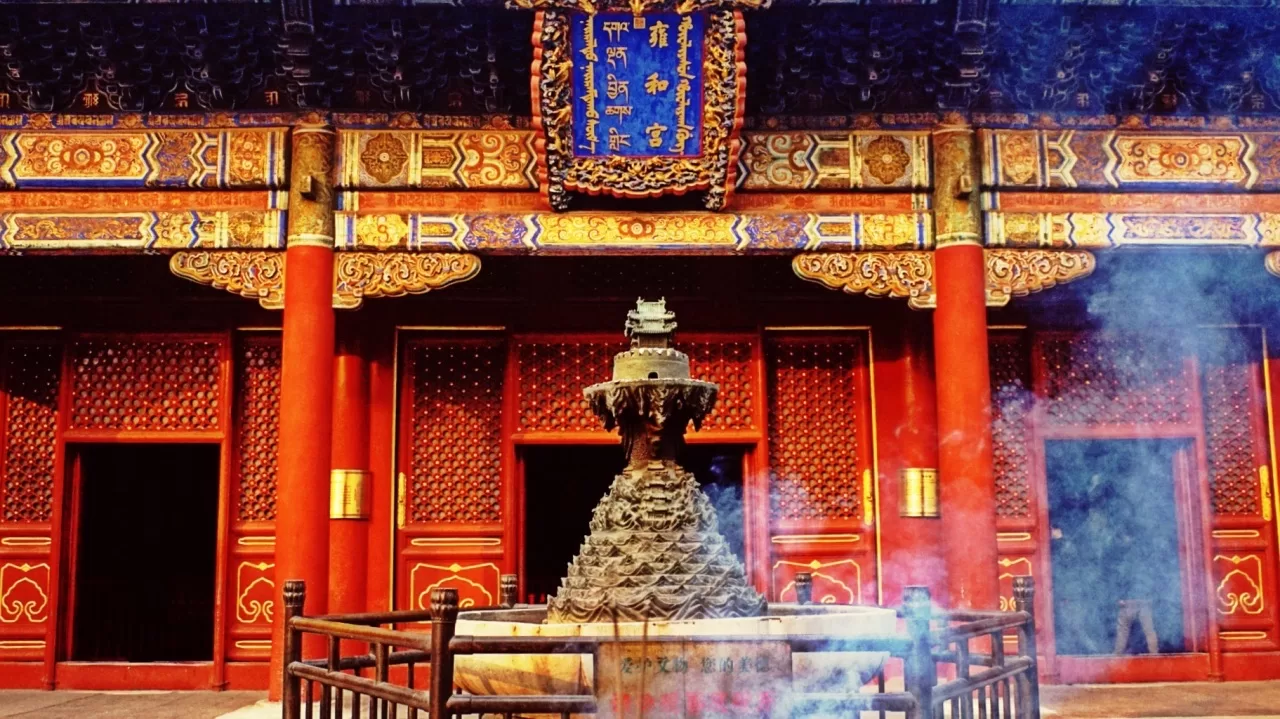
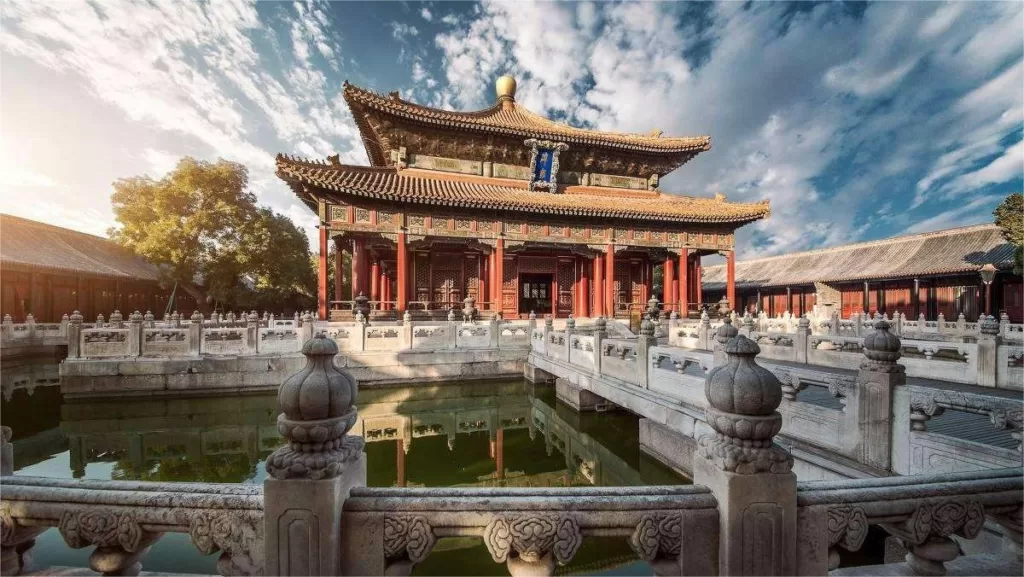
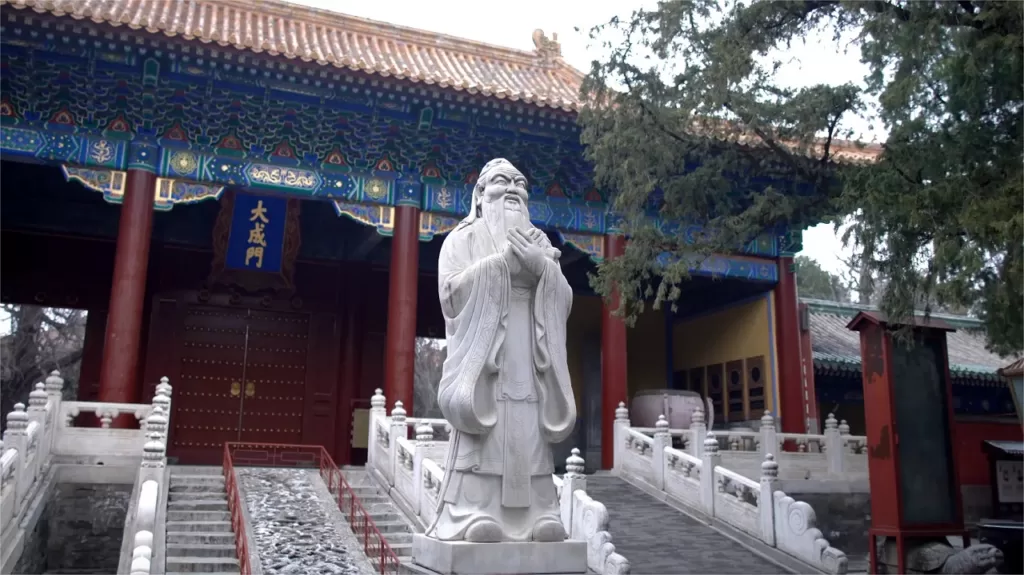
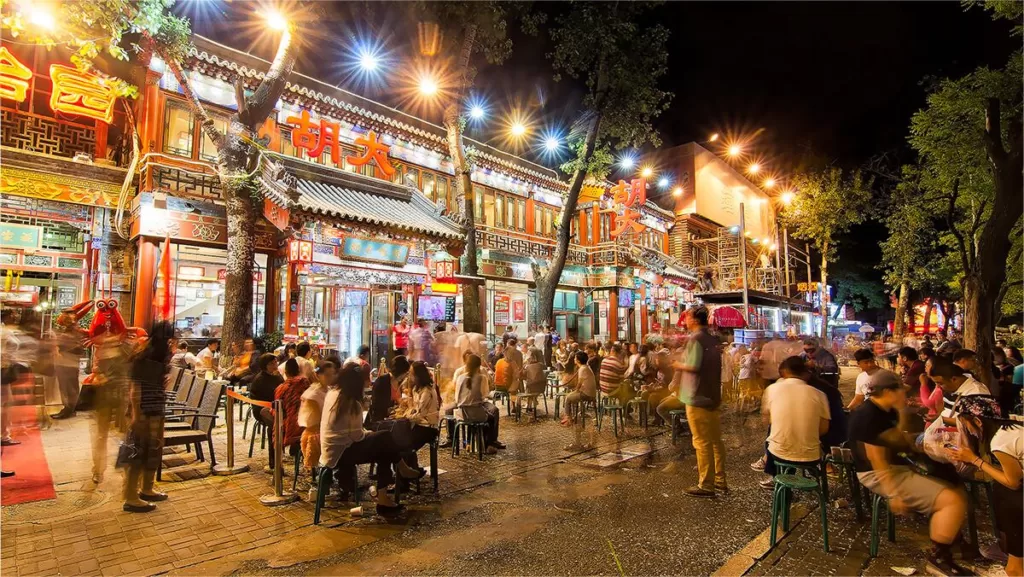

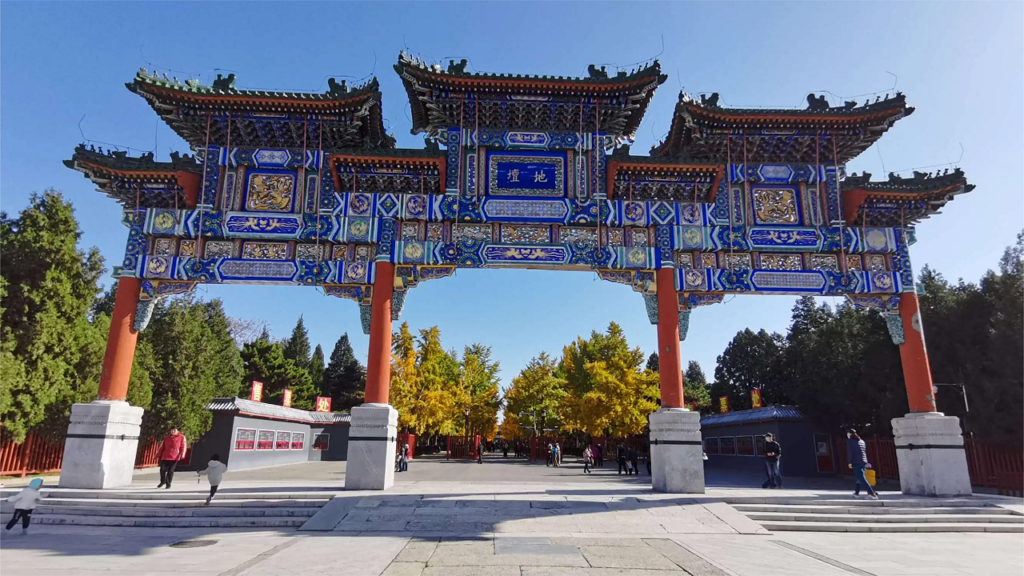
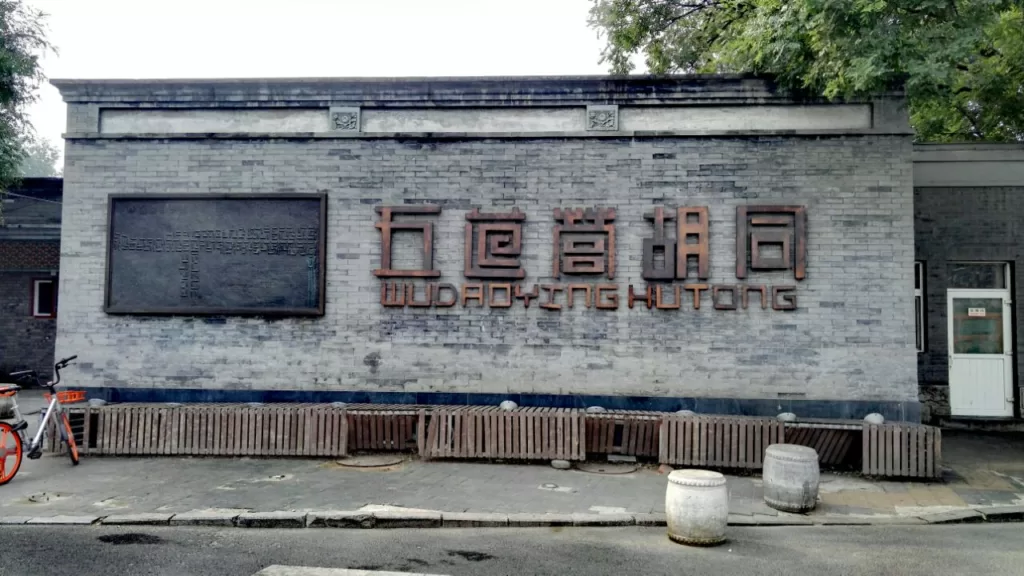

I arrived at 8:20 this morning and there was already a line ahead. However, since the entrance opens at 8:30 on weekends, I got through the line quickly after just ten minutes! I recommend that everyone not bring bags; if you go to the far right security check, you’ll get through in just three seconds!
In the winter, there are still quite a few people at the Yonghe Temple, especially as the New Year approaches. Everyone comes with their hopes and wishes for the upcoming year, seeking blessings at the temple, believing that sincerity will bring about fulfillment.